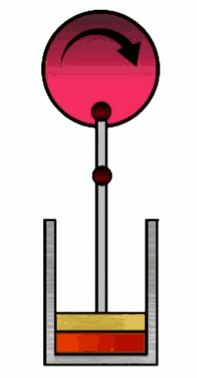
Let me ask you a question.
How does your bike or a car run?
It’s because of the engine. Right?
Engine is the heart of any vehicle.
But how does this actually work? Well, there is a cyclic process occurring inside the engine in which the fuel burns and converts the heat energy into mechanical work (see above animation)
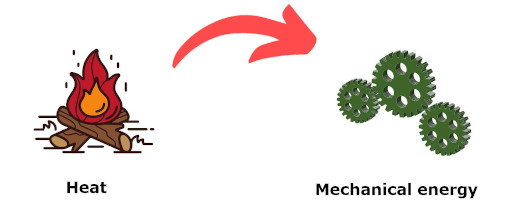
Here I will give you the exact conceptual knowledge about the Carnot cycle with lots of images to make you understand the entire carnot cycle very easily (scroll down to see images)
I will also explain to you how this carnot engine works on the basis of carnot cycle.
I’ll also discuss the pv diagram of the carnot cycle.
So let’s get started.
Contents
A story (I mean history)
In 1824, this actual working process of engines was explained by engineer Sadi Carnot. This process is known as Carnot cycle.
Sadi Carnot explained about what should be the parts of the engine?
He also explained what should be the ideal engine, and he also explained what should be the various processes through which an engine should go through, for producing some work from it.
In 1824, Sadi Carnot gave the exact theoretical explanation of the engine. He explained about the different parts of the engine and he also explained about all the processes involved in the working of the engine.
During this theory on carnot engine he made few assumptions, so this engine is an ideal engine (hypothetical engine)
Sadi Carnot designed this engine which is 100% efficient.
[Note: Carnot engine is just an ideal engine (or hypothetical engine). No engine has 100% efficiency according to second law of thermodynamics]
What is the Concept?

In simple terms, any engine that converts heat energy into mechanical energy is known as a heat engine.
Carnot suggested that, if a heat engine is passed through some thermodynamic stages, then it may be possible to get 100% efficiency of the heat engine.
This engine is called the Carnot engine or ideal heat engine.
He suggested the working process for this Carnot engine and this cyclic process is known as Carnot cycle.
4 parts of Carnot heat engine
1). Insulated non conducting stand
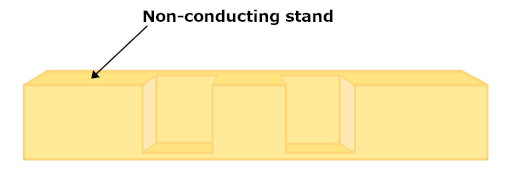
Carnot heat engine consists of an insulated stand which does not conduct heat through it. In other words there is no heat transfer through this stand.
2). Hot reservoir

The other part of the carnot engine is the hot reservoir. This hot reservoir is such that its higher temperature remains constant. This is also known as heat source.
3). Cold reservoir
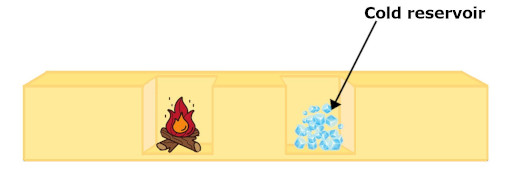
This is a cold reservoir which remains at the constant lower temperature. The temperature of the cold reservoir remains lower only during the entire process. This cold reservoir is also known as heat sink where heat is released.
4). Cylinder with a working fluid
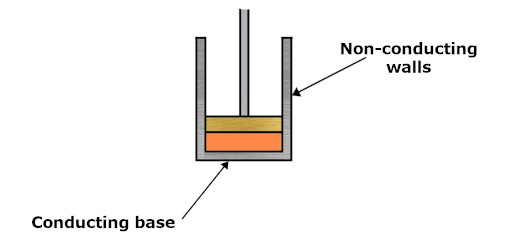
Now here is the main part. A cylinder which is having non conducting walls (insulated walls) through which no heat transfer takes place.
The cylinder has a conducting base and heat transfer takes place through this base of the cylinder. The cylinder is fitted with a piston which reciprocates up and down as shown in the picture.
There is a working fluid inside the cylinder which expands and contracts during the process.
4 process in Carnot Cycle with pv diagram
There are four process involved in the Carnot cycle
- Isothermal expansion
- Adiabatic expansion
- Isothermal compression
- Adiabatic compression
Let us discuss all these 4 processes of carnot cycle along with the pv diagram. (It is really simple)
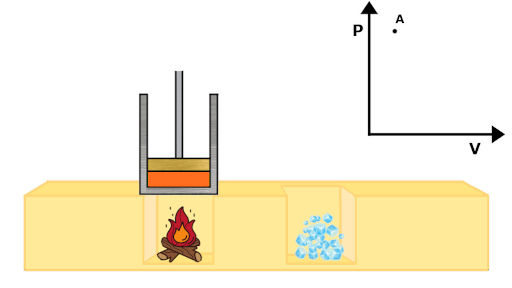
First of all, place the cylinder on the hot reservoir. Because of this, the heat transfer will take place from the hot reservoir to the gas filled inside the cylinder (as the cylinder base is conductive).
1). Isothermal expansion
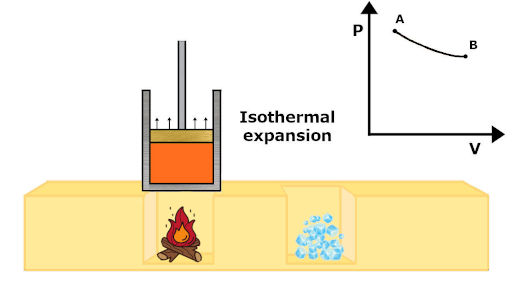
During the isothermal expansion process, the gas expands in the cylinder. Also, the piston rises upward as shown in the above Image. Because of this, the expansion of gas takes place at a constant temperature. So this expansion process is known as isothermal expansion.
In the pv diagram, it is represented as A to B.
2). Adiabatic expansion
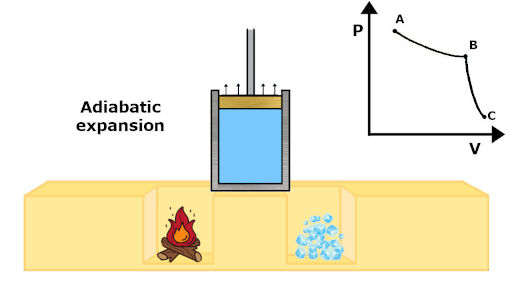
Now the cylinder is placed on the insulated stand. As the stand and cylinder walls are insulated, there will be no heat transfer from any side. So it’s an adiabatic process.
But the piston of the cylinder will rise upward due to the inertia of the wheel (you can refer the very first animation).
Due to this, the expansion takes place. And as this expansion takes place without any heat transfer, it is known as adiabatic expansion.
In the pv diagram, the Adiabatic expansion process is represented as B to C.
3). Isothermal compression
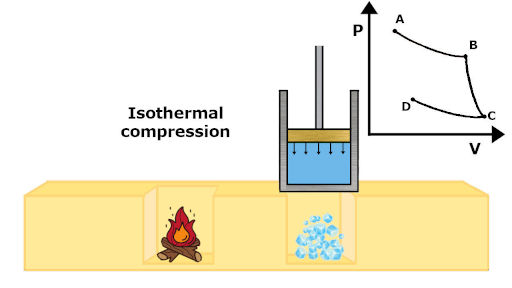
Now place the cylinder on the cold reservoir (or heat sink).
Because of this, the heat will be rejected to the sink. But the piston also moves downward due to the inertia effect of the wheel. Thus the compression process takes place and the temperature of the gas remains constant as heat is rejected to the sink. So this process is known as isothermal compression process.
On the pv diagram, the isothermal compression process is mentioned by the curve C to D.
4). Adiabatic compression
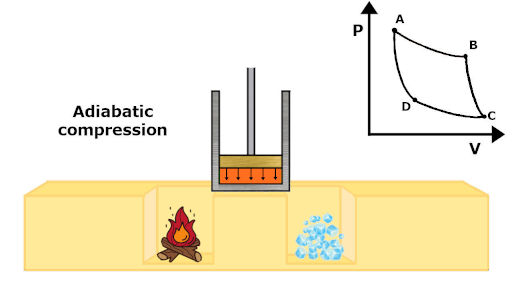
Now, the cylinder is placed again over the insulated stand.
The piston will keep on moving downward as shown in the image due to inertia effect of the wheel. But here, the cold reservoir is not present to absorb the heat. So it is an Adiabatic process. Also the compression of gas takes place as the piston moves downward, so it is a compression process. Thus this entire process in which compression of gas takes place without heat transfer is known as adiabatic compression.
This process is shown on the pv diagram as D to A.
After this step, the gas returns to its initial stage and this complete cycle is known as Carnot cycle.
The energy working on this cycle is called the Carnot engine.
I hope you have clearly understood the entire concept of carnot cycle. If you have any doubts, feel free to comment below. Also let me know whether you have clearly understood this topic or not.
Important Guides for you
Also read:
- What is thermodynamics? (35+ topics with definitions and examples)
- Zeroth law of thermodynamics
- What is First law of thermodynamics?
- First law of thermodynamics definition/statement (In simple way)
- Examples of First Law of Thermodynamics / Law of conservation of Energy
- First law of thermodynamics equation (A practical explanation)
- Limitations of First Law of Thermodynamics
- What is second law of thermodynamics? [8+ Best examples to remember the law]
- Examples of Second Law of Thermodynamics (8+ best examples)
- Second Law of Thermodynamics Definition/Statement (Next level explanation)
- Second Law of Thermodynamics Equation [Practical explanation]
- What is third law of thermodynamics? (in simple terms)
- Laws of thermodynamics
- What is the definition of entropy in thermodynamics?
- Heat capacity vs specific heat in thermodynamics
- What is Thermodynamic Equilibrium? (With Best Example)
- Thermodynamic Process (With Examples)
- What is Thermodynamic System? – Open, Closed & Isolated system (With Examples)
